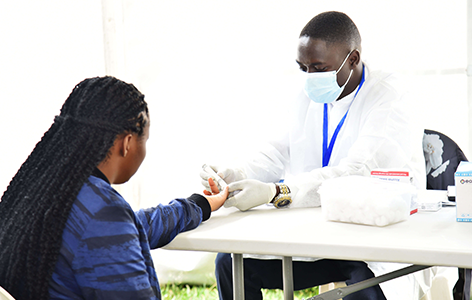Kampala, Uganda — The Uganda AIDS Commission (UAC) has reported a significant decline in both AIDS-related deaths and new HIV infections, marking a major milestone in the country’s fight against the epidemic.
Speaking to the Parliamentary Committee on HIV/AIDS and Related Matters on Wednesday, October 15, Tom Etti, UAC’s Director for Partnership, revealed that annual AIDS deaths fell by 64%, from 56,000 in 2010 to 20,000 in 2024. New HIV infections also dropped sharply, from 96,000 to 37,000 over the same period.
“These are impressive gains that reflect Uganda’s resilience and the strong leadership driving our national response,” Etti said.
The report indicates that Uganda is approaching the UNAIDS 95-95-95 targets: 94% of people living with HIV know their status, 90% are on antiretroviral therapy (ART), and 96% of those on treatment are virally suppressed. More than 1.4 million Ugandans are currently receiving ART.
“These results show we are close to epidemic control and provide a strong foundation for accelerating toward the Presidential Fast-Track Initiative goal of ending AIDS as a public health threat by 2030,” Etti added.
While national progress is evident, district-level data shows the epidemic remains geographically uneven. Central and peri-urban districts bear the highest burdens. Wakiso District has 180,300 people living with HIV and 3,950 new infections, followed by Kampala with 73,600 PLHIV and 1,840 new infections. Buikwe has 30,100 PLHIV and 600 new infections; Mukono 26,800 PLHIV and 570 new infections; Luwero 25,000 PLHIV and 560 new infections; and Mubende 24,000 PLHIV and 540 new infections.
High prevalence rates are particularly notable in urban centers. Fort Portal City recorded 14% adult prevalence, Kyotera 13%, while Kalangala District and Soroti City are around 12%, highlighting persistent localized transmission risks.
Parliamentary committee members raised concerns about remaining gaps. Sarah Kayagi, Committee Chairperson and Namisindwa District Woman Representative, questioned why over 4,700 children were still being born with HIV despite prevention efforts. “It is deeply worrying that thousands of children are still infected at birth. We need to identify what is failing in the mother-to-child prevention chain,” Kayagi said. She also highlighted the disproportionate number of young girls infected, noting that out of 37,000 new infections last year, 21,000 were girls and 11,000 boys.
Etti acknowledged these challenges, emphasizing that while Uganda’s maternal HIV response has improved, mother-to-child transmission requires intensified focus, particularly in regions with limited access to antenatal care and timely ART initiation.
The UAC presented an HIV Sustainability Roadmap aimed at reducing reliance on donor funding and increasing domestic financing. The plan sets targets for at least 60% of non-commodity HIV costs to be domestically funded by 2027, rising to 80% by 2030, through mechanisms such as the National Health Insurance Scheme, health bonds, and debt-to-health swaps.
“By strengthening partnerships, investing in prevention, and integrating HIV into all development programmes, Uganda can end AIDS as a public health threat by 2030,” Etti said.
Committee members urged renewed sensitization campaigns and more funding. Michael Kakembo (NUP, Entebbe Municipality) warned that condom use has declined and called for targeted awareness campaigns. Denis Oneka Lit (FDC, Kitgum Municipality) praised the Commission’s achievements but emphasized the need for more interventions to reach men, who remain disproportionately affected.
